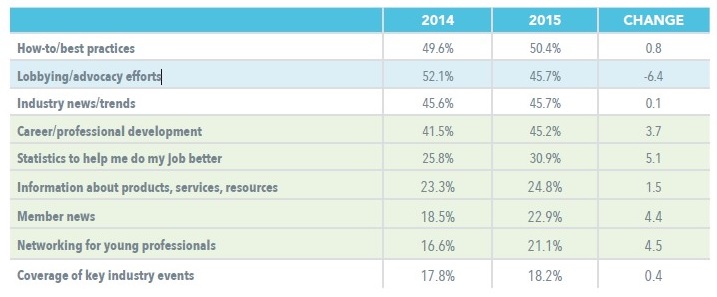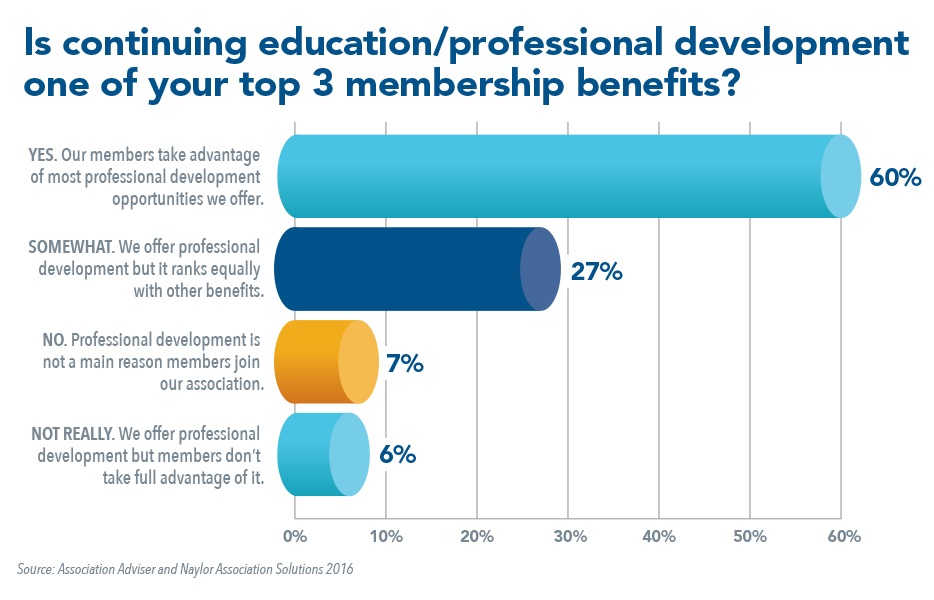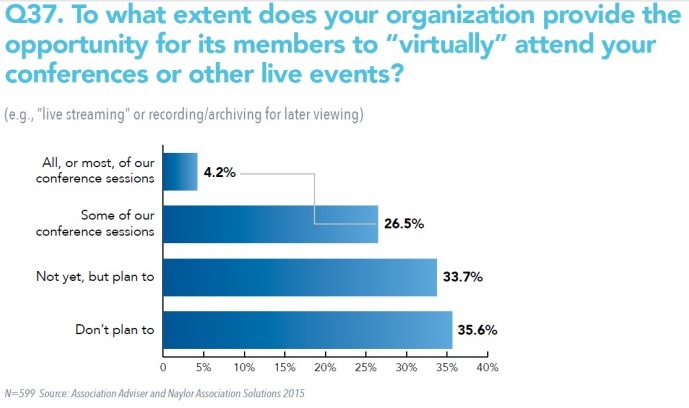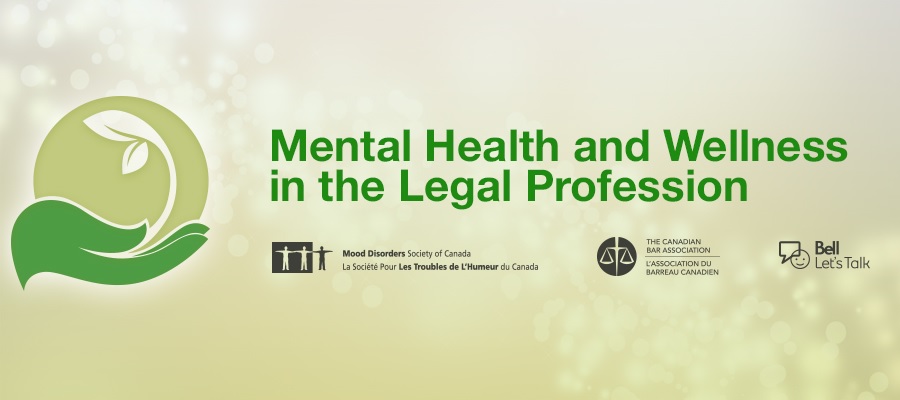Associations Help Members Close the Skills Gap

You’re listening to a less-than-polished speaker at a prestigious national conference or symposium and wondered to yourself, “How did she (or he) get to be executive director of that association?” C’mon. Admit you’ve done this.
“What are they doing that I’m not doing?” you ask yourself. Or more likely, “What the heck am I doing wrong?” Ancient Roman philosopher Seneca would say, “Good luck is what happens when preparation meets opportunity.” But there might be more to it than just good luck and good preparation.
![]()
Bring education to your members rather than bringing your members to the education.
Help members with more than just technical competency—don’t neglect stress management, relationship skills, resiliency and creativity.
Your online career center isn’t just for members looking for a job–it should be a portal they visit regularly for professional advancement.
A 2015 Fortune magazine report indicated that nearly two-thirds of companies have positions for which they can’t find qualified applicants and Manpower Group’s annual U.S. Talent Shortage Survey found that 32 percent of American employers had trouble filling jobs in 2015. Yet million millions of well-educated workers remain unemployed, underemployed or stuck full-time in unchallenging or otherwise unfulfilling work. How can that be?
Manpower cited a “persistent skills gap” and Fortune said the jobs our economy has created over the past two years “are very different from the ones lost in the recession that followed the 2008 financial crisis.” Fortune also said technology is automating routine jobs and widening the skill gaps for jobs that remain—i.e. “changing the very nature of work and giving us ever less time to adapt.”
But, is changing technology the root cause of today’s hiring disconnect and skills gap? Our research indicates there’s more to the story. For instance, our annual association communication benchmarking study found that four of the 10 most important topics to association members are now career related (it wasn’t this way when we started the study five years ago):
- How/to best practices,
- Career/professional development,
- Statistics to help me do my job better and
- Networking for young professionals.
Types of information most important to association members

Your current job may not be your first career rodeo, but everyone from the receptionist to the executive director can feel unsure of themselves in the modern workplace. Whether it’s delivering a presentation, leading a Skype conference call, managing a big team project or posting on social media, everyone seems to be wary of pressing the wrong button, saying the wrong thing at the wrong time or not knowing a “best practice” that everyone else in the room seems to know. As Betsy Monseu explains in today’s Corner Office profile, “I wish I had something like our Tomorrow’s Leadership Program when I was starting my own career.”
Associations step up to fill the gap
That’s where associations come in. They’ve always been a trusted bridge between an industry’s workers and an industry’s employers. An unscientific poll of Association Adviser readers found that for 60 percent of respondents, CE is a Top-3 membership benefit. For another 27 percent of respondents, CE was an important membership benefit at least on par with other benefits.

Generational divide
Generational differences may also be disrupting traditional mentoring, succession planning and passing of the learning torch. Sharon Kneebone, executive director of the National Society of Histotechnology told Association Adviser TV that like many organizations, “we’re seeing Boomers retiring and they’re not as inclined to train their successors as other generations are.” That only widens the skills gap, she added. Kneebone said that’s an opportunity for associations to step up and create structured training programs that help everyone from industry newcomers to longstanding members keep their skills relevant and gain the knowledge they need to be promoted. “The needs haven’t changed,” said Kneebone. “What has changed dramatically is how we deliver on those needs.”
Watch Sharon Kneebone discuss how associations can step up and create structured training programs that help everyone from industry newcomers to longstanding members keep their skills relevant and gain the knowledge they need to be promoted.
Another unscientific poll of our readers found that live classroom training is the most popular way for members to earn continuing education credits, followed by attending live events and taking virtual classroom courses. Virtual learning has been gaining traction in recent years as travel budgets and time spent out of the office remain at a premium. Our annual association communication benchmarking study found that in 2015, nearly one-third of associations (30.7 percent) allow members to access at least some of their live event content virtually, up substantially from 20.6 percent who said so in 2011. Further, our research found that another one-third of associations (33.7 percent) are planning to offer virtual attendance options in the near future.

Tracy Tompkins, business development director for Naylor Learning Solutions, recently published a 2-part series about virtual and hybrid events. According to Tompkins, a virtual event can feature multiple sessions (as opposed to a single topic webinar or webcast), and may include keynote presentations, training, educational workshops, discussion areas, exhibits or other features. Virtual event “activities” can take place in real time, on demand or as a combination of both. Additionally, some organizations add a “trade show” component to their virtual events. Rather than competing with your live events, Tompkins said virtual events can be a “welcome, practical addition to your association’s event lineup.” Virtual events offer convenience and flexibility for speakers and attendees, which expands the number of presenters and attendees who can participate. Also, since virtual events often cost less to produce than live events, the non-dues revenue opportunities (and operating margins) help the association’s bottom line and keep dues in check.
Blended approach to CE
ACC’s Monseu said nothing can replace the power of face-to-face interaction, but her organization takes a “blended approach” to providing professional education and networking opportunities for members. In addition to holding three well-attended live conferences every year, ACC produces a monthly webcast series (Coal Q&A), which is free to members and available at a nominal cost to non-members, and offers a year-long Tomorrow’s Leadership program that includes admittance to ACC conferences plus invitations to networking dinners with industry leaders. Leadership program participants also work on year-long projects with their peers and share their results on Coal Q&A webcasts. “It’s a nice combination of networking, face-to-face and virtual learning,” added Monseu.
Life and wellness skills
John Hoyles, CEO of The Canadian Bar Association, told us that one of CBA’s most widely used professional development benefits is the Mental Health and Wellness in the Legal Profession initiative. It’s a four-module online course that give lawyers, judges and law students information about mental health and addiction issues, their causes and symptoms and prevention treatment options. “Our survey of members and non-member attorneys across the country found that 68 percent had big concerns about depression, stress and anxiety. It’s not just about identifying these issues, but learning how to avoid them. Response has been absolutely amazing,” said Hoyles.

Amanda Kaiser, a qualitative member researcher and former marketing director at the National Association of Colleges and Employers, believes associations are really good at teaching “profession-specific” skills, but need to work more on teaching life skills such as relationship skills, influencing skills, resilience skills and creative skills. Kaiser explains more:
- Relationship Skills – Continued corporate cost cutting increases high-stress environments putting extreme pressure on work relationships. Ninja-like relationship skills can help members enhance collaboration even in tough times.
- Resilience Skills – Resilience is a mode of learning that allows professionals to continue trying and not give up, which is critical for solving difficult business challenges.
- Creative Skills – Creativity is the ability to imagine many unique ways to solve complex business problems. Professionals from all walks of life need to learn how to unlock creativity in themselves and in their co-workers.
- Influencing Skills – Selling ideas, often with no direct authority, is a significant challenge for professionals today. Our members’ success hinges on how well they learn to influence others.
These skills may be considered “outside the professional development track” but they are desperately needed, added Kaiser. For more about this topic follow Kaiser at SmoothThePath.net or on Twitter @SmoothThePath.
Career development vs. professional development
According to Carrie McIntyre, senior director, New Business Development, Boxwood Career Solutions, associations are very good at providing professional development resources for members and stakeholders, but could do more to help them with career management. An association’s online career center should not just be a place that members visit when looking for a job; it should be a “portal they visit regularly to ensure they’re aware of every available career advancement tool,” added McIntyre. Click here for more about this topic.
Taking learning to the members
Dawn Rose, executive director of The American Society for Healthcare Human Resources Administration, said ASHHRA would like to “expand its reach” beyond the mid- to senior-level HR executive and get deeper into non-hospital healthcare settings. Healthcare increasingly takes place in the community, explained Rose, so it’s important to “expand our certification program to [reach] new levels of [caregivers] and to leverage technology so members can learn, connect and build their careers.”
Watch Dawn Rose talk about diversifying and expanding your membership by using technology in a more proactive way
Brenda Orffer, director of members services for the Washington Healthcare Association (WHCA), said her organization has also looked for ways to “take education to the members rather than bringing members to the education.” Five years ago, fledgling webinars taught WHCA that members appreciated the convenience of not having to travel to keep their skills current and so did their employers. Since many facilities serve “vulnerable populations” Orffer said it’s a hardship to have nurses and other caregivers out of the building for even one day. To that end WHCA developed a new “Group Retro” program, in which live presenters go directly to a member’s facility and train staff on-site using their own equipment in a familiar setting. For instance, if you’re explaining how to lift and transfer a patient, Orffer said it’s far more effective to instruct in a live situation than through a book and hope that the knowledge is transferred to a live situation.
Watch Brenda Orffer discuss ways the WHCA takes education to members rather than bringing members to the education.
The American Society of Interior Designers (ASID) has made a concerted effort to tailor continuing education programs around a designer’s “career trajectory” and to supplement learning that is not provided on the job or in school. For emerging professionals, ASID CEO Randy Fiser said the Society offers programs on business strategy, leadership skills and advancing one’s career path. For more experienced designers, Fiser said ASID created “Impact Summits” that bring together practice leaders and experts from other disciplines to improve the profession’s understanding of health, wellness, sustainability and resiliency. Fiser said ASID is also big on filming its education sessions, so members who miss a session can access it later online.
Watch Randy Fiser talk about focusing in on education as it relates to career stages by offering courses you wouldn’t have been taught in school.
Training loyal employees vs. industry contributors
Of course, some organizations worry that investing too much in staff development increases the risk that employees will leave for greener pastures. “When I hear that, my response is always, ‘Yes, but what if you DON’T develop them…and they stay,’” observed Jamie Notter, founding partner of Culture That Works, LLC. As much as we love loyalty, Notter said “we’re not always honest about the dark side of loyalty.” Rita Chen Fujisawa, chief operating officer of the California Association of Health Facilities, agreed there can be a downside to low employee turnover. Everyone’s been here a long time. It makes it harder to innovate and think outside the box. You get a lot of “we tried it before and it didn’t work.” Fujisawa said, “My response is always to ask why it didn’t work last time and ‘Did you ever consider doing it this way?’”
Conclusion
As psychologist and philosopher Erich Fromm once said, “Creativity requires the courage to let go of certainties.” And maybe a little bit of luck to make your way in this constantly changing uncertain world.
Hank Berkowitz is the moderator-in-chief of Association Adviser eNews.

